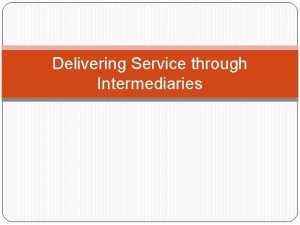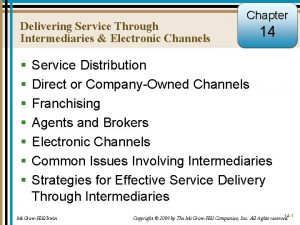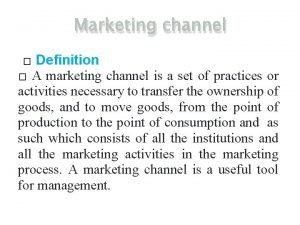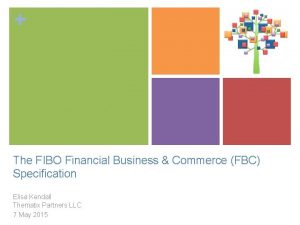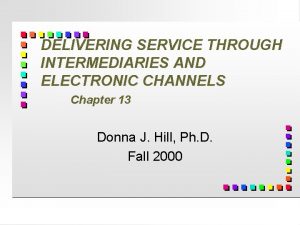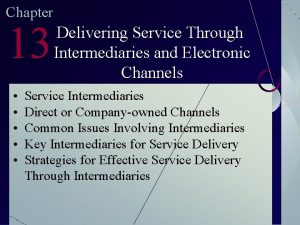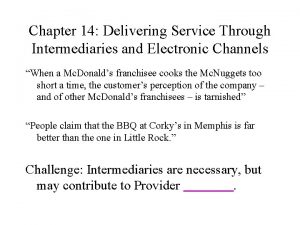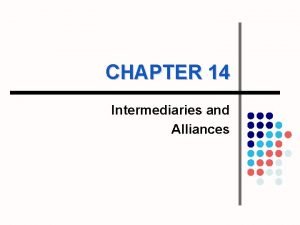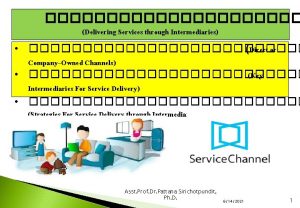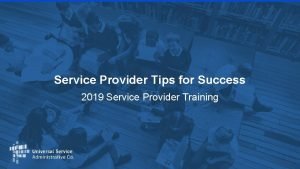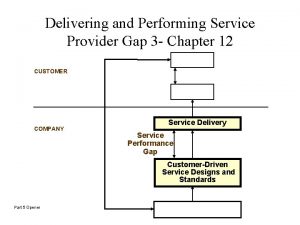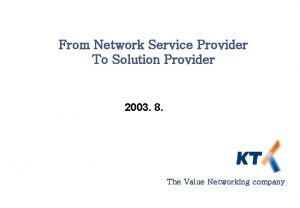Delivering Service through Intermediaries Service Provider Participants Service















- Slides: 15

Delivering Service through Intermediaries

Service Provider Participants �Service principal (originator) �creates the service concept (like a manufacturer) �Service deliverer (intermediary) �entity that interacts with the customer in the execution of the service (like a distributor/wholesaler)

Services Intermediaries � Franchisees �service outlets licensed by a principal to deliver a unique service concept it has created � e. g. , KFC � Agents and Brokers �representatives who distribute and sell the services of one or more service suppliers � e. g. , insurance agents � Electronic Channels �all forms of service provision through electronic means � e. g. , distance learning

Franchising �Most common type of distribution of services �Works well with services that can be standardized and duplicated through the delivery process, service policies, warranties, guarantees, promotion and branding �It is a relationship or partnership in which the service provider – develops and optimizes a service format that it licenses for delivery by other parties – the franchisees




Benefits and Challenges for Franchisers of Service � Benefits: � Challenges: �Leveraged business �Difficulty in format for greater expansion and revenues �Consistency in outlets �Knowledge of local markets �Shared financial risk and more working capital maintaining and motivating franchisees �Highly publicized disputes and conflict �Inconsistent quality �Control of customer relationship by intermediary

Benefits and Challenges for Franchisees of Service � Benefits: � Challenges: �An established �Encroachment business format �National or regional brand marketing �Minimized risk of starting a business �Disappointing profits and revenues �Lack of perceived control over operations �High fees

Agents and Brokers �An agent w acts on behalf of a service principal or a customer and is authorized to make agreements between the principal and the customer �A broker is an intermediary who brings buyers and sellers together while assisting in negotiation �Agents and brokers have legal authority to market services as well as to perform other marketing functions on behalf of producers

Benefits and Challenges in Distributing Services through Agents and Brokers � Benefits: �Reduced selling and distribution costs �Intermediary’s possession of special skills and knowledge �Wide representation �Knowledge of local markets �Customer choice � Challenges: �Loss of control over pricing �Representation of multiple service principals

Electronic Channels �These channels do not require human interaction �Various services are made possible through such vehicles which include movies on demand, remote health services etc. �Use of electronic channels helps in overcoming some of the problems associated with service inseparability

Benefits and Challenges in Electronic Distribution of Services � Benefits: � Challenges: �Consistent delivery for �Price competition standardized services �Low cost �Customer convenience �Wide distribution �Customer choice and ability to customize �Quick customer feedback �Inability to customize with highly standardized services �Lack of consistency due to customer involvement �Changes in consumer behavior �Security concerns �Competition from widening geographies

Common Issues Involving Intermediaries �conflict over objectives and performance �difficulty controlling quality and consistency across outlets �tension between empowerment and control �channel ambiguity

Strategies for Effective Service Delivery Through Intermediaries � Control Strategies: � Empowerment Strategies: �Measurement �Help the intermediary �Review develop customeroriented service processes �Provide needed support systems �Develop intermediaries to deliver service quality �Change to a cooperative management structure � Partnering Strategies: �Alignment of goals �Consultation and cooperation
 Role of intermediaries in service delivery
Role of intermediaries in service delivery Electronic channels of distribution
Electronic channels of distribution Soa architecture
Soa architecture Delivering quality service
Delivering quality service Define marketing channels
Define marketing channels What is financial intermediation
What is financial intermediation Types of financial intermediaries
Types of financial intermediaries Types of financial intermediaries
Types of financial intermediaries Zurich intermediaries protection
Zurich intermediaries protection Financial intermediaries
Financial intermediaries Financial intermediaries
Financial intermediaries Bluestone for intermediaries
Bluestone for intermediaries Financial intermediaries
Financial intermediaries Participants in money market
Participants in money market Financial intermediaries
Financial intermediaries Fifa regulations on working with intermediaries
Fifa regulations on working with intermediaries
